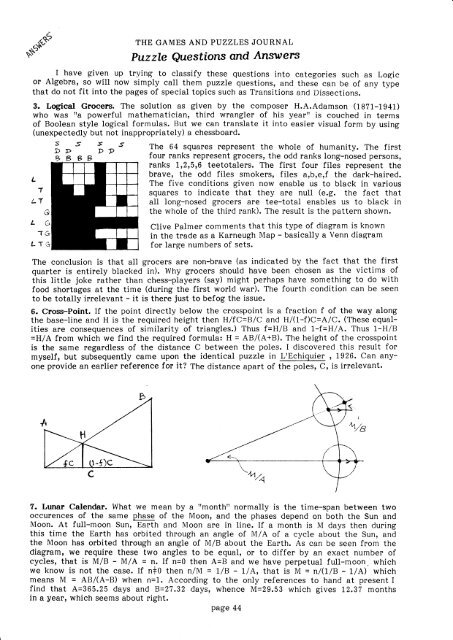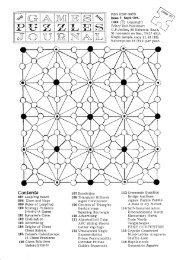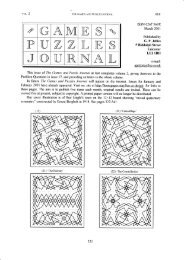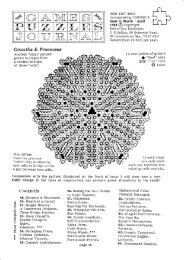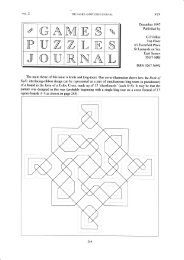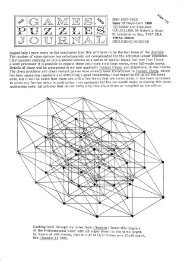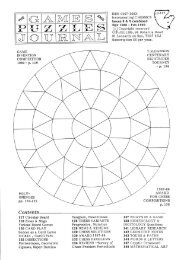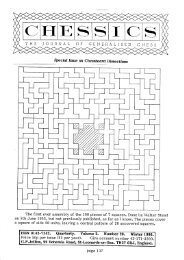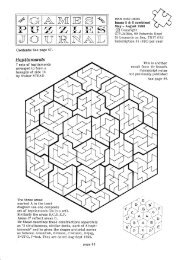The Games and Puzzles Journal, #3 - Mayhematics
The Games and Puzzles Journal, #3 - Mayhematics
The Games and Puzzles Journal, #3 - Mayhematics
- No tags were found...
You also want an ePaper? Increase the reach of your titles
YUMPU automatically turns print PDFs into web optimized ePapers that Google loves.
$<br />
THE<br />
GAMES AND PUZZLES JOURNAL<br />
Puzzle Questfons cnd AnstPens<br />
I have given up trving to classif;g<br />
_<br />
these questions into categories such as Loqic<br />
or Algebra, so will now simply call them puzzle questions, <strong>and</strong> these can be of any type<br />
that do not fit into the pages of speeiat topics such as Transitions <strong>and</strong> Dissections.<br />
3. Logical Groeers. <strong>The</strong> solution as given by the composer H.A.Adamson (18t-1941)<br />
who was t'a powerful mathematician, third wrangler of his year'r is couched in terms<br />
of Boolean style logical formulas. But we can translate it into easier visual form by using<br />
(unexpectedly but not inappropriately) a chessboard.<br />
L<br />
'r<br />
I-T<br />
G<br />
LG<br />
1G<br />
LTG<br />
s.sj's<br />
DD<br />
9geB<br />
D9<br />
<strong>The</strong> 64 squares represent the whole of humanity. <strong>The</strong> first<br />
four ranks represent grocers, the odd ranks long-nosed persons,<br />
ranks LrzrSrG teetotalers. <strong>The</strong> first four files represent the<br />
brave, the odd files smokers, files a,b,e,f the dark-haired.<br />
<strong>The</strong> five eonditions given now enable us to black in various<br />
squares to indicate that they are null (e.g. the fact that<br />
all long-nosed grocers are tee-total enables us to black in<br />
the whole of the third rank). tne result is the pattern shown.<br />
Clive Palmer comments that this type of diagram is known<br />
in the trade as a Karneugh Map - basically a Venn diaqram<br />
for large numbers of sets.<br />
<strong>The</strong> conclusion is that all grocers are non-brave (as indicated by the fact that the first<br />
quarter is entirely blacked in). Why grocers should have been chosen as the victims of<br />
this little joke rather than chess-players (say) might perhaps have something to do with<br />
food shortages at the time (during the first world war). <strong>The</strong> fourth condition can be seen<br />
to be totally irrelevant - it is there just to befog the issue.<br />
6. Cross-Point. If the point directly below the crosspoint is a fraction f of the way along<br />
the base-line <strong>and</strong> H is the required height then H/fC=B/C <strong>and</strong> H/(1-f)C=A/C. (<strong>The</strong>se equalities<br />
are consequences of similarity of triangles.) Thus f=H/B <strong>and</strong> l-f=H/A. Thus 1-HlB<br />
=H/A from which we find the required formula: H = AB/(A+B). <strong>The</strong> height of the crosspoint<br />
is the same regardless of the distance C between the poles. I discovered this result for<br />
myself, but subsequently came upon the identical puzzle in LrEchiquier , L926. Can anyone<br />
provide an earlier reference for it <strong>The</strong> distance apart of the poles, C, is irrelevant.<br />
7. Lunar Calendar. What we mean by a itmonthil normally is the time-span between two<br />
occurences of the same phase of the Moon, <strong>and</strong> the phases depend on both the Sun <strong>and</strong><br />
Moon. At full-moon Sun, Earth <strong>and</strong> Moon are in line. If a month is M days then during<br />
this time the Earth has orbited through an angle of M/A of a cycle about the Sun, <strong>and</strong><br />
the Moon has orbited through an angle of M/B about the Earth. As can be seen from the<br />
diagram, we require these two angles to be equal, or to differ by an exact number of<br />
cycles, that is MlB - M/tr = n. If n=0 then A=B <strong>and</strong> we have perpetual full-moon. which<br />
we know is not the case. If ntO then n/M = l/B - l/A, that is M = n/(l/B - 7/N which<br />
means M = AB/(A-B) when n=1. According to the only references to h<strong>and</strong> at present I<br />
find that A=365.25 days <strong>and</strong> B=27.32 days, whence M=29.53 which gives 12.37 months<br />
in a year, which seems about right.<br />
page 44


